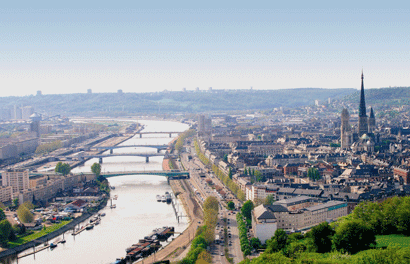The town of Versailles possesses an elegance and style reminiscent of Paris and, of course, as it was once the centre of government, this should come as no surprise. Three wide avenues lead to the Place d’Armes in front of the imposing façade of the palace. Not far from the Palace is the Tourist Office at 12 Rue de la Chancellerie which should undoubtedly be your first port of call to collect maps with which to find the main attractions. It is open seven days a week. Tel: 33 (0) 1 30 97 89 89. In the area around the bustling market, one can find many colourful cafés and bistros and nearby is the quarter of the ‘antiquaires’ which is well worth a visit. The Marché Notre-Dame of Versailles itself was founded by Louis XIV and is, in fact, one of the most famous markets in the world. It has four sections each surmounted by a mansarded roof , ‘au Puits’ (Wells) ‘à la Fontaine’, ( Fountain) ‘à l’Avoinne’, (Oats) and ‘`à la terre’ (Earth) Versailles town also boasts a fine Cathedral, that of St Louis, constructed in 1743 – 1754 and elevated to the rank of Cathedral in 1802. The Clicquot organ is very famous, having 3,636 pipes.
Book a Hotel in Versailles Town
Jeu de Paume
Of the many places of interest to be found in the town, one which ranks high on the historical list is the court of ‘Jeu de Paume’ just off the Avenue de Sceaux, in the Rue du Jeu de Paume. In this indoor tennis court with its covered spectator gallery, an early form of tennis was played by the king and courtiers. The only one of its kind, it heralded the birth of the present day scoring system of tennis, 15, 30, 40. The spectators in the gallery were protected by a net but the game did not always take place across a net. Sometimes it was simply a line drawn on the floor. The ‘Salle’ of the ‘Jeu de Paume’ is best known, however, as the birthplace of the revolution, as it was here on the 20th June 1789, that the Third Estate met and took their oath of defiance which led ultimately to the storming of the Bastille. Admission is free and it is open on Saturdays and Sundays from May-September from 14.00 – 17.00. . Tel: 01 30 83 77 88.
Potager du Roi
A little further afield just across the road from the Cathedral at 10, Rue Maréchal Joffre, is the ‘ Potager du Roi’ or the King’s vegetable garden. (www.potager-du-roi.fr ) An ornate gilded gateway leads to the Palace Park and it was the route by which the King would visit his kitchen garden. The garden covers 9 hectares of land divided into squares. It was created in the 17th Century at the request of Louis XIV. The largest part which extends to 3 hectares, is divided into sixteen equal squares set around a central ‘bassin’. Each square in the old days was surrounded by espaliered fruit trees and contained vegetables. There is a ‘jardin anglais’ at one end, designed by Chalgrin for the Countess of Balbi, favourite of the Count of Provence. The garden was listed in 1926 as a ‘monument historique’. Now maintained by the École Nationale Supérieure du Paysage (National School of Horticulture), the gardens are open 7 days a week from April to October from 10.00 – 18.00 Weekends and Holidays. Tel: 33 (0) 1 39 24 62 62
The Stables
The stables, which are part of the Palace, are in fact situated just outside the grounds opposite the main entrance to Versailles Palace. They were designed for Louis XIV by Hardouin-Mansart and built in 1682. The Main stables or ‘Grand Ecurie’ houses the horses and there are regular displays of ‘spectacle équestre’. The Equestrian Performance Academy specialises in teaching equestrian arts and is open to the public all the year round. In the summer there are spectacular equestrian displays, accompanied by music, fountains playing and fireworks within the grounds of Versailles, called the ‘Fêtes de Nuit’. To the other side of the courtyard is the ‘Petit Ecurie’ where you can visit the Coach Museum, open Saturdays and Sundays from 9 – 18.30 from April to October. Here you can observe a variety of coaches including the Funeral Coach of Louis XVIII drawn by 8 horses originally and the Coronation Coach of Charles X which was designed in 1814 with the intention of using it for the coronation of Louis XVIII but was actually finished for the coronation of Charles Xi in Reims in May 1825. This coach was also used for the baptism of the Imperial Prince, son of Napoleon III and the Empress Eugénie in 1856. www.versailles-tourisme.com
Copyright: text : Sarah Francis.







